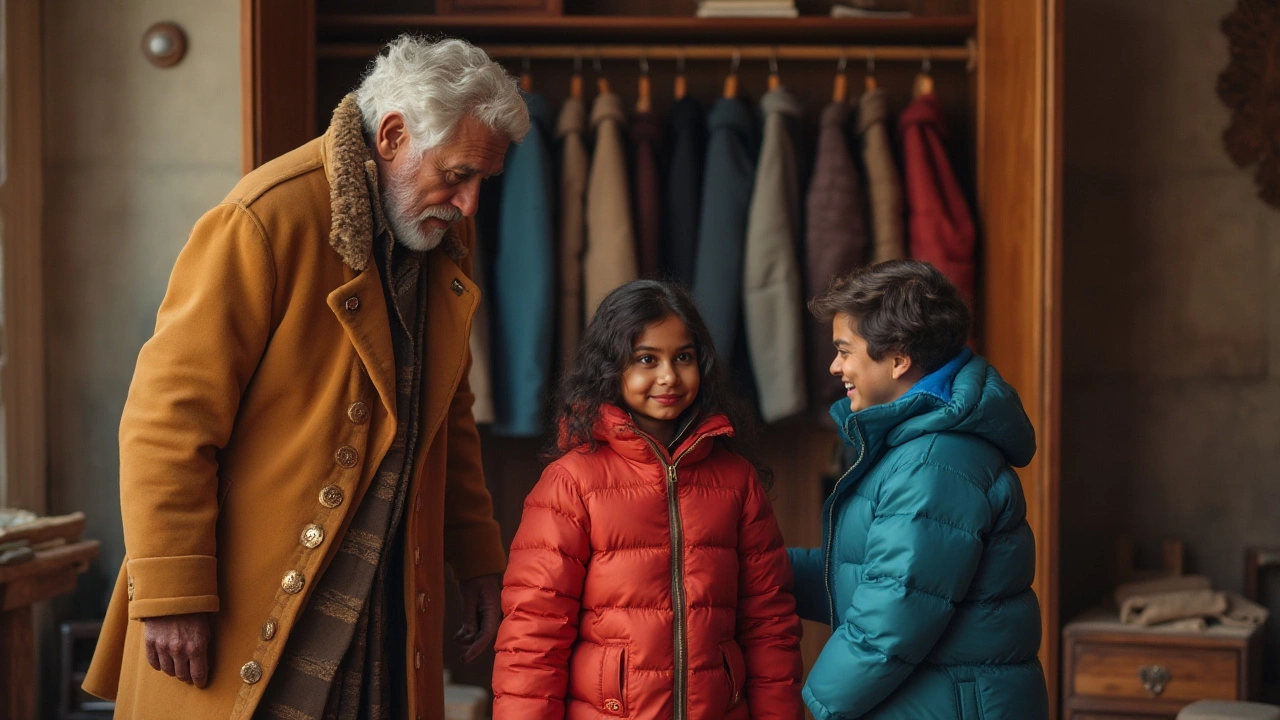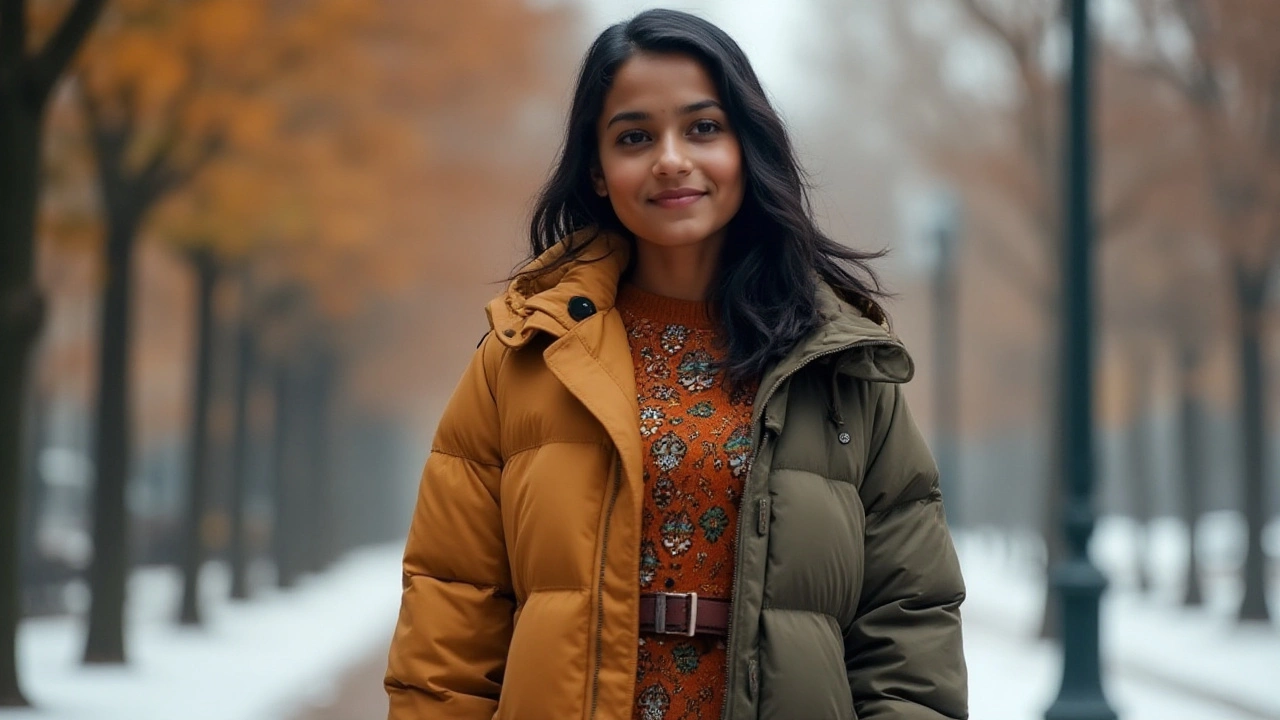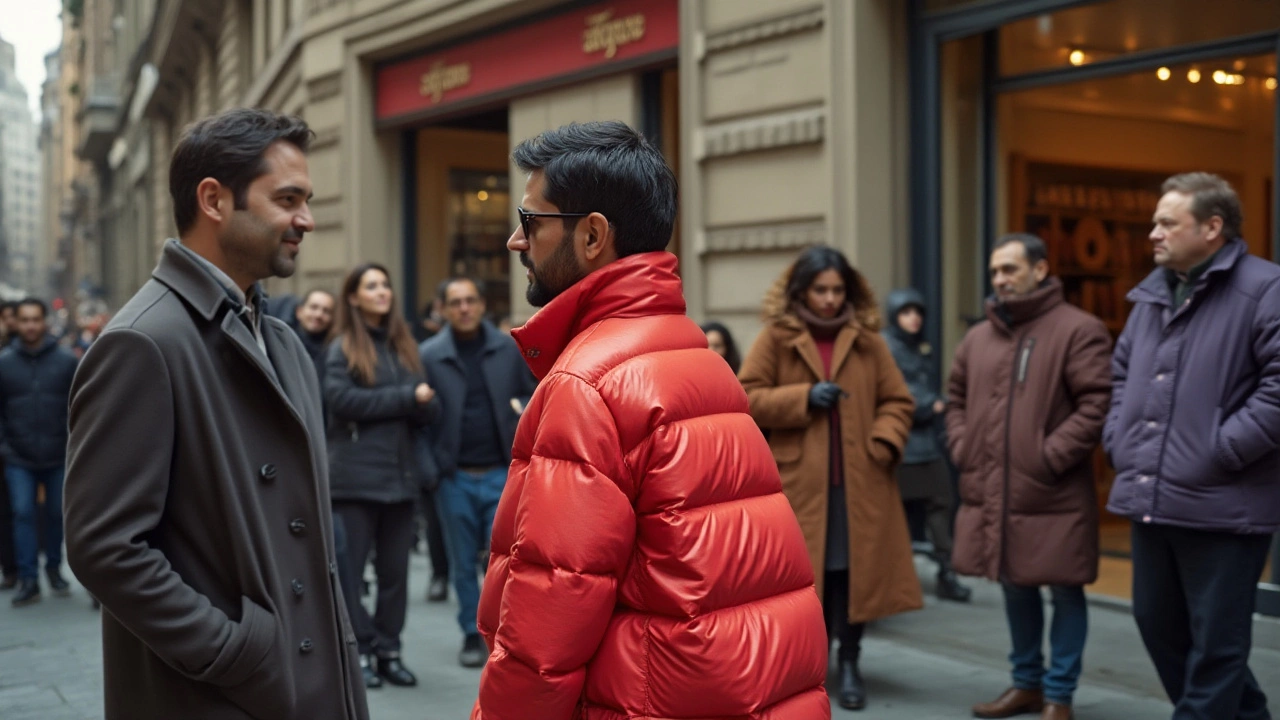Deciding between a traditional coat and the modern-day puffer jacket often pits style against functionality. Both of these winter staples serve distinct purposes, making each unique in its way. The decision largely depends on personal preference, needs, and specific circumstances.
When temperatures drop and winter wind begins its relentless chase, your outerwear becomes more than just a fashion statement. It transforms into protective armor against the cold. We’ll explore not just the technical aspects of keeping warm, but also the sartorial influence these garments have.
Whether you're navigating urban streets or hiking snowy trails, choosing the right outerwear is essential. Let's dive into the intricate world of winter wear and uncover which option might be better suited for you.
- Historical Background
- Functionality and Warmth
- Occasion and Style
- Material and Durability
- Environmental Impact
- Practical Tips
Historical Background
The journey of outerwear, from traditional coats to the cozy puffer jacket, paints a captivating story of fashion evolution intertwined with societal needs. Coats have been a staple since ancient times, with variations seen in many cultures. The medieval era brought us the cloak, an early form of coat, designed to shield the elite from harsh weather while exuding an aura of sophistication. These garments were often richly adorned, highlighting wealth and status. As the centuries unfolded, coats became increasingly practical, adapting to the needs of emerging industries and armies. By the 18th century, the greatcoat had emerged, a rugged piece favored by military personnel, constructed for warmth and durability. Made of heavy wool, it served both as insulation and a canvas for adornment, with epaulettes and gold trimming punctuating the seams.
The puffer jacket, a relatively recent invention, introduces a contemporary twist to this timeline. Born out of necessity, its origins date back to the 1930s when adventurer Eddie Bauer designed the first version. After a near-fatal experience with hypothermia, Bauer sought a garment that could offer unparalleled warmth without the bulk. Thus, the down-insulated puffer jacket was created, setting off a revolution in cold-weather gear. It was groundbreaking not only for its use of down feathers but for its stitched compartments that kept the feathers evenly distributed. It's fascinating to note, however, that this practical jacket didn't hit mainstream fashion until much later, capturing public imagination in the '70s and '80s thanks to its practicality and style statement.
"The puffer jacket not only keeps the cold at bay but has become a bold statement in the world of fashion," notes a leading fashion historian.
The trajectory of the coat and the puffer jacket reflects broader social and technological trends. The rise of urban environments necessitated fashionable yet functional attire, while advances in fabric technology and manufacturing processes enabled innovation. Today, both garments serve as potent symbols of identity and utility, drawing from a rich heritage. At the intersection of past and present, they offer unique insights into the human endeavor to blend formality with warmth, fashion with practicality. As we move forward, it's compelling to consider how future designs may further redefine what's possible in the realm of winter wear.
Functionality and Warmth
When it comes to choosing between a puffer jacket and a classic coat, functionality and warmth are essential considerations. The primary role of any winter outerwear is to shield against the chill, and each garment achieves this in unique ways. A puffer jacket, for instance, is renowned for its excellent insulation properties. Thanks to its signature quilted design filled with either down or synthetic fibers, a puffer traps heat efficiently and provides superb warmth even in extreme cold. This makes it a favored option for those who find themselves battling harsh winter elements or for people who enjoy outdoor sports and activities during the colder months.
On the other hand, a traditional wool or cashmere coat might not boast the same level of insulation as a puffer, but it offers a different kind of warmth. These coats utilize dense materials that are naturally adept at blocking wind and retaining heat, offering a cozy shield against icy breezes. Moreover, they're often treated to be water-resistant and can hold up well in light rain or snow. The type of insulation a wearer needs often depends on their lifestyle. For urban environments or situations where style is a priority, a coat may provide just the right balance of warmth and sophistication.
Practicality is also a key factor. Puffer jackets, with their multiple pockets and hooded versions, often cater to those who require functionality in their daily wear. Some models are designed with high-tech fabrics that adapt to temperature changes, providing even more comfort during unpredictable weather shifts. This makes them a pragmatic choice for those who prioritize convenience. A historical perspective reveals how both these garments evolved significantly since their inception, each adapting to fulfill modern-day functional demands.
For those pondering which to choose, it's worth considering an insightful point by renowned designer Michael Kors:
“Puffer jackets have a way of marrying comfort with high fashion, providing warmth while transcending the concept of bulky winter wear.”This quote highlights how the puffer jacket has evolved from its humble beginnings into a trendy yet practical winter staple. Meanwhile, fashion houses have been crafting coats that serve as versatile additions to any wardrobe, sometimes offering features such as detachable liners and aesthetic detailing that add to their appeal without compromising on warmth.
Some data comparing the average insulation levels can be useful in making a decision. Below is a simple illustrative table comparing typical insulation values:
| Garment | Insulation Value |
|---|---|
| Puffer Jacket (Down) | 600-800 fill power |
| Puffer Jacket (Synthetic) | 400-600 fill power |
| Wool Coat | 500-700 fill power equivalent |
| Cashmere Coat | 600-750 fill power equivalent |
It's intriguing to note how both choices offer varied pros and cons, ultimately serving distinct purposes. While a puffer jacket excels in outdoor scenarios with its adaptability and cozy warmth, a coat is often the go-to for formal environments and milder climates. Whether you lean towards the insulated embrace of a puffer or the elegant allure of a coat, understanding their respective functional and warmth attributes ensures you make a choice that best suits your needs.

Occasion and Style
When contemplating the choice between a coat and a puffer jacket, understanding the social and stylistic implications can be a game changer. Traditionally, long coats adorn the promenades of formal and semi-formal events, offering a sleek silhouette and a touch of timeless elegance. The classic trench or wool coat, for example, effortlessly pairs with a business suit or evening dress, making it the darling of office goers and gala attendees alike. Their structured cuts and refined aesthetics make them a staple for prestigious settings.
Meanwhile, the puffer jacket has surged in popularity, embodying a more urban and versatile flair. With an array of colors and designs that cater to both adventurous spirits and fashion-forward individuals, it’s no surprise they're a favorite in casual meet-ups, weekend trips, and even streetwear culture. Many celebrities and fashion icons have been spotted rocking stylish puffers, showcasing its stylish adaptability. As Vogue once put it, “The puffer jacket's iconic status stems from both its practicality and its pure visual impact, a shell of warmth encasing high fashion.”
The Versatility of Puffers
Not confined to casual days, puffer jackets are increasingly tailored to crossover into the smart casual territory. With advancements in materials, some puffers now offer a slimmed down design that aligns with business casual attire. This blend of fashion-forward thinking means that you might now see puffers even at semi-formal occasions, where a splash of modernity is encouraged. By contrast, traditional coats, boasting materials like cashmere or wool, deliver insulation with an air of sophistication but might falter during outdoor activities or under heavy snow.The flexibility of a coat cannot be undermined, however. Many coats are adaptable to various scarf styles, hats, and gloves, making them a chameleon in the world of fashion, adjusting well to both the corporate ladder and a winter wedding. It allows the wearer to maintain a polished appearance, no matter the unpredictability of winter weather. The opinion of the Retail Revival Report found that a growing number of consumers wanted winter wear that balances economy, style, and function, indicating the coat as a steadfast option amongst many.
Ultimately, the choice between these garments can hinge on the event at hand. For a meeting with investors or attending a formal ceremony, a long woolen coat is often irreplaceable. In contrast, enjoying a winter hike or attending a casual dinner with friends might incline one towards a puffer for its functional comfort and style.
Material and Durability
When discussing the durability of puffer jackets and coats, material choice becomes a primary consideration. At its core, a coat often relies on natural fabrics like wool, cashmere, or cotton. Wool, known for its robust qualities, offers incredible durability, with some woolen coats lasting decades if cared for properly. Wool fibers intertwined create a dense fabric that not only traps heat but also resists wear and tear excellently. Cashmere, though more delicate, provides a touch of luxury with a surprising amount of warmth for its weight. Cotton, being more versatile, finds its way into trench coats or lighter varieties, boasting breathability and comfort.
On the flip side, puffer jackets predominantly feature synthetic materials such as polyester or nylon, known for their water-resistant properties. Polyester, a form of plastic, ensures your puffer jacket guards against the elements, especially in damp or snowy conditions. This material doesn’t retain water, which is a game-changer when you're on the go. Nylon, another synthetic marvel, is light yet tough, making it an ideal choice for those who need both freedom of movement and reliable protection.
The classic insulation method for puffer jackets is a fascinating one, often using down or synthetic insulation to trap warmth. Down, derived from duck or goose feathers, offers unmatched insulation by creating loft that traps air and retains heat. However, care must be taken as down can lose its ability to insulate when wet, unless the outer material is water-resistant. In recent years, synthetic insulations like PrimaLoft have gained popularity, boasting similar insulating abilities even in wet conditions without the ethical concerns associated with down. This brings us to an important quote:
"Synthetic materials in puffer jackets have revolutionized warmth and comfort without the weight," says Anna Kaplan, a renowned textile engineer.
Durability is also affected by stitching and style. Coats often have reinforced seams, adding structural integrity. Double-breasted styles offer an overlapping layer of fabric, which not only enhances warmth but also provides additional fortification against the wind. Puffer jackets rely on quilted patterns, stitching small pockets where insulation sits, ensuring consistent warmth throughout the garment. It's essential to pick a jacket with quality stitching, as loose threads could diminish the warmth and lifespan of the jacket.
Maintenance plays a crucial role in longevity. Coats can often simply be brushed clean, but might require professional dry-cleaning. On the other hand, many puffer jackets are machine washable, a significant convenience. Always check the label instructions to avoid damage. According to Global Market Insights, the puffer jacket market is seeing a significant uptick, with the segment expected to reach over USD 20 billion by 2027. This is a testament to their rising popularity and the role materials like synthetic fibers play in that growth.
In this dance between durability and maintenance, both coats and puffer jackets find their niche. Your selection hinges on lifestyle demands, climate sensitivities, and personal aesthetics. Whether you choose the timeless elegance of a coat or the innovative warmth of a puffer jacket, each choice reflects a balance between the materials that shield you and the durability required to last through countless winters.

Environmental Impact
When considering the choice between a puffer jacket and a traditional coat, it is vital to take into account their environmental footprints. The manufacturing process, choice of materials, and durability are key factors that determine the ecological consequences of these popular outerwear options. As awareness of climate change and sustainability grows, consumers are beginning to weigh the significance of their fashion choices in a more eco-conscious light.
One of the primary concerns with puffer jackets is the material used for insulation. Many puffer jackets utilize synthetic insulation such as polyester, which is derived from petroleum. This process not only consumes non-renewable resources but also contributes to pollution during production. An estimated 70 million barrels of crude oil are used each year globally just to produce polyester! On the other hand, coats are often made from natural fibers like wool, which is biodegradable and has a lower environmental impact, though sheep farming can result in its own set of ecological concerns.
In recent years, brands have started to capitalize on technological advancements by producing puffer jackets with eco-friendly alternatives, like recycled polyester and even insulation made from hemp or bamboo fibers. Meanwhile, the traditional coat market is also seeing a rise in sustainable options, such as organic wool and ethically sourced cashmere. The longevity and quality of a well-made coat can help mitigate its environmental impact, as it avoids the rapid fashion cycle that puffer jackets can sometimes fall into, given their trend-driven nature.
One key initiative aiming to reshape the outerwear industry is the promotion of circular fashion. This includes promoting practices like recycling, resale, and clothing rental, which can help extend the life of both coats and puffer jackets. According to the Ellen MacArthur Foundation, shifting towards a circular business model could reduce greenhouse gas emissions from the fashion industry by roughly 50% by 2030. This monumental impact underscores the importance of shifting consumer behavior, aligning it with more sustainable practices.
"Every time you purchase a recycled polyester puffer jacket or a coat made of ethically harvested wool, you significantly reduce your carbon footprint," notes sustainable fashion activist Lucy Siegle. "We each have a role to play in its improvement."
While some environmentally-focused manufacturers strive to enhance the durability and update the design of puffer jackets, this can lead to an increase in their lifespan, rivaling that of high-quality coats. Consumers should look for brands that have adopted transparent supply chains and provide detailed information about the materials used and the processes undertaken to create these garments. Brands that participate in certification programs like Bluesign and GOTS are especially commendable, as they undergo rigorous checks to meet sustainability standards. By choosing wisely and being informed, consumers can align their outerwear choices with their ecological values, creating a positive impact.
The environmental impact of our fashion choices is a complex puzzle comprised of various interlinked factors. From resource consumption to longevity, each element demands careful attention. By staying informed and making more conscientious decisions, individuals can champion a more sustainable future, purchase by purchase, helping clear a path towards ethical fashion without compromising style or function.
Practical Tips
When it comes to choosing between a puffer jacket or a classic coat, practical considerations can tremendously aid your decision. Both have admirable qualities, but several aspects might make one a better fit for your specific wardrobe needs and lifestyle. Begin by evaluating your typical daily activities. For instance, if you're commuting in an urban environment, a coat’s structured elegance might serve you well, especially if your day involves formal meetings. Coats are often constructed from wool or other heavy fabrics, which are resilient and provide adequate warmth for moderate climates. However, do note that a thick wool coat might not fare as well under drenching rains compared to a puffer jacket which usually offers some degree of water resistance.
Consider the type of climate you reside in. In places known for harsh, windy winters, a puffer jacket with its air-trapping fill can be an excellent shield against the biting cold. These jackets often come with adjustable hoods, elasticized cuffs, and high collars, playing a critical role in retaining heat. On the other hand, if style is pivotal to you, and you often find yourself attending events that require a sharp appearance, a coat with its timeless appeal can seamlessly blend with elegant outfits.
When choosing the right piece of outerwear, practicality should also reflect in the ease of maintenance. Most puffer jackets boast synthetic materials such as polyester, making them easy to clean and more resistant to stains, while coats made of natural fibers like wool might require dry cleaning and can be more susceptible to wear and tear. Another consideration is storage and travel. If you're frequently on the move, a puffer jacket might be ideal owing to its light weight and packability. There are even models available now that can compress into a small pouch, making it a traveler's favorite companion.
From a financial viewpoint, understanding your budget is another important aspect. High-quality coats can cost a pretty penny, reflecting craftsmanship and fine materials. Meanwhile, affordable options in the realm of puffer jackets have emerged, offering warmth without the heavy price tag. Take into account, however, that investing in a pricier, durable option might save you money in the long run as it can last for many seasons.
For insights from seasoned trendsetters, one might echo the words of renowned fashion designer Diane von Furstenberg who once said,
“Style is something each of us already has, all we need to do is find it.”Keep this mantra in mind as you embark on your outerwear journey. The perfect choice doesn’t just warm your body, but also resonates with your personal style, creating a harmonious blend between aesthetics and functionality.
Many people also weigh the chance to align their choices with a greater environmental responsibility. More brands are now focusing on sustainable practices, using recycled materials for puffer jackets and ethically sourced fabrics for coats. Supporting such brands not only aligns with a personal commitment to environmental mindfulness but also represents a shift in the apparel industry toward more sustainable and eco-friendly practices.
